Speed requires new authorities and champion teams.
Unit X weaponized Other Transaction Agreements to award prototypes in months, not years.

Book summary
by Raj M. Shah & Christopher Kirchhoff
How the Defense Innovation Unit rewired procurement for a new era
The inside story of the Pentagon team that pipelines Silicon Valley tech
Topics
Read this as both a case study in organizational innovation and a blueprint for public-private partnerships. Use Readever to highlight the specific mechanisms that enabled rapid technology adoption, and note the cultural translation challenges between Silicon Valley and the Pentagon. The AI insights will help you understand the patterns of successful innovation in bureaucratic environments.
Things to know before reading
Shah and Kirchhoff recount the birth of Unit X (later DIU), the Pentagon experiment that embedded venture-style scouts among startups to rapidly field AI, autonomy, and sensor tools for warfighters. Through anecdotes about Anduril, SpaceX, Shield AI, and dozens of lesser-known suppliers, they show how cultural translation—not just contracts—decides whether the military can keep pace with authoritarian rivals.
Three frictions keep appearing: procurement inertia, cultural mismatch, and ethics.
Unit X weaponized Other Transaction Agreements to award prototypes in months, not years.
The best ‘unicorn wranglers’ could explain Pentagon acronyms to founders and venture math to four-stars.
Unit X cancelled flashy projects when data rights, bias, or escalation risks weren’t addressed.
Ready to continue? Launch the Readever reader and keep turning pages without paying a cent.
Use the authors’ playbook to understand the new “fast lane” authorities (Other Transaction Agreements, commercial solutions openings) and the soft skills—mission-driven storytelling, founder empathy, agile prototyping—that let small companies survive the valley of death between demos and deployment.
Key idea 1
Unit X weaponized Other Transaction Agreements to award prototypes in months, not years.
By colocating military officers with venture scouts in Mountain View, the team bypassed 500-page RFPs and instead posted problem statements, inviting startups to pitch working code within weeks. The book outlines how to brief acquisition lawyers, align with combatant commands, and scale a pilot once it proves itself in theater.
Remember
Key idea 2
The best ‘unicorn wranglers’ could explain Pentagon acronyms to founders and venture math to four-stars.
Shah and Kirchhoff emphasize convening rituals—demo days in hangars, classified tech rodeos, rotations that embed officers at venture firms. These rituals humanize both communities and keep teams motivated through inevitable policy setbacks.
Remember
Key idea 3
Unit X cancelled flashy projects when data rights, bias, or escalation risks weren’t addressed.
The authors confront dilemmas around autonomous targeting, surveillance, and private capital shaping war. They argue for transparent kill-switch policies, human-on-the-loop requirements, and compensation models that don’t make founders dependent on forever wars.
Remember
Startup founders eyeing defense contracts.
DoD civilians or service members trying to modernize acquisitions.
Policy staffers crafting guardrails for AI and autonomy.
Raj M. Shah is a former F-16 pilot, venture capitalist, and the first managing partner of DIUx. Christopher Kirchhoff served on the National Security Council, co-founded the Pentagon's Silicon Valley office, and later led Google's crisis response lab. Together they bring both operator and policymaker perspectives.
Build your personalized reading stack
Download full-length ePubs in one click with personal cloud storage.
Blend AI-guided insights with tactile note-taking to accelerate reflection.
Follow curated reading journeys tailored to your goals and time budget.
Sync highlights across devices so lessons stick beyond the page.
Sign in to Readever to keep reading with AI guidance, instant summaries, and synced notes.
Start reading Unit X for free and unlock personalized book journeys with Readever.